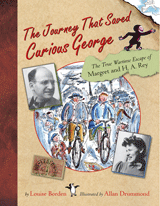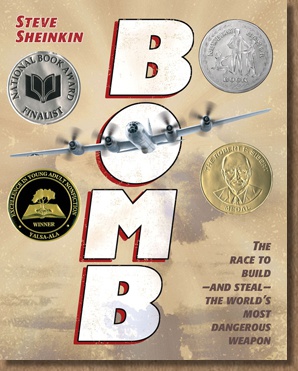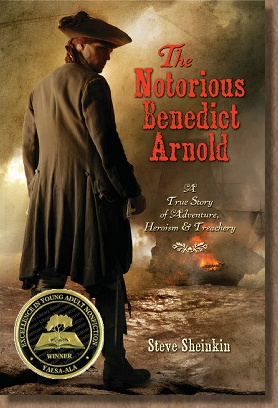Fleishman, Sid. (2008). The Trouble Begins at 8: A Life of Mark Twain in the Wild, Wild West. New York: GreenWillow Books/Harper Collins. 224 pages. ISBN 9780061344329
Awards/Selection
Lists:
- Richie's Picks- Richie's Picks Nonfiction titles
Author's Website: http://sidfleischman.com/
- Nonfiction titles from ALSC Notable Books lists 2002-2013
- Richie's Picks- Richie's Picks Nonfiction titles
Author's Website: http://sidfleischman.com/
Brief Summary: Most people remember Mark Twain, or Samuel L. Clemens, as an east coast and Missouri man, clever and cantankerous, but funny and brilliant. Many people know that he was a river boat captain in his younger days. Some may even know that he worked in many newspaper offices. But what few people seem to know is that Mark Twain had his own Wild West adventure, starting with the journey to Nevada where his older brother became the only Secretary of the territory. What did Clemens think of the Wild West? How did he get on? What is his connection to gold rush fever, California, and the Hawaiian islands? How did these adventures contribute to his becoming a published author? How did they shape the famous man we know of today?
Personal Reaction: As I'm finding with many of the books I am reading for this non-fiction blogging assignment, I really enjoyed this book. Now, I chose this book specifically because Mark Twain is one of my favorite literary and historical figures. He had a notoriously wicked sense of humor, sarcasm and satire, he loved to stir things up and challenged standard notions of righteousness and propriety. He just had to think for himself and be different and that, I admire. He was distinctive and devoted, talented and troubled. He wasn't perfect but he was colorful and brilliant, and his story inspires me and reminds me that it's ok to be different. In fact, it's probably the best thing I can think of.
At first I thought I was keeping in time well enough with the chronology of events, only to read at the end that many of these accounts may have been inaccurate because of Twain's love of embellishment for the sake of a good story. Then I'd shake my proverbial fist at the memory of Mark Twain, while smiling a wry smile, and I would try to make sense of what happened. Perhaps this is why the author offers so much back matter, to help with the quest. Or perhaps that was Twain's idea all along. "Can't make it easy for 'em, " I can imagine him saying with a wink.
At first I thought I was keeping in time well enough with the chronology of events, only to read at the end that many of these accounts may have been inaccurate because of Twain's love of embellishment for the sake of a good story. Then I'd shake my proverbial fist at the memory of Mark Twain, while smiling a wry smile, and I would try to make sense of what happened. Perhaps this is why the author offers so much back matter, to help with the quest. Or perhaps that was Twain's idea all along. "Can't make it easy for 'em, " I can imagine him saying with a wink.
Front/Back Matter: Title page, copyright page, dedication, table of contents, Preface, content, timeline, references (by chapter and page), illustration and photograph sources, bibliography, "The novels and other works", index.
Content Evaluation: By far the most organized and complete set of back matter in any non-fiction book I have read to date, Fleischman was spot on the mark. He makes it easy for anyone to not only check facts, but keep events in order, reference particular time periods, events and topics and provides sources for further review and study. It really speaks to the dedication of the writer to portray events as accurately as possible and to give a complete picture of such a famous man's life.
I like Fleishman's tone because it is humorous and personal, though once you read at the end of the book that the way the events are depicted might not be accurate kind of turns you on your ear, as far as believing in his pure credibility goes. But perhaps he's wanting us to evaluate for ourselves what is factual and what is not. Still, the book is entertaining, informative and I believe accurately portrays the character of Sam Clemens.
I like Fleishman's tone because it is humorous and personal, though once you read at the end of the book that the way the events are depicted might not be accurate kind of turns you on your ear, as far as believing in his pure credibility goes. But perhaps he's wanting us to evaluate for ourselves what is factual and what is not. Still, the book is entertaining, informative and I believe accurately portrays the character of Sam Clemens.






